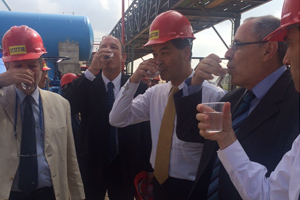
|
Seawater desalination by reverse osmosisIsrael has a population of about 8 million and has low rainfall. Water resources management is therefore of great importance to the country. One of my activities in Israel today was to visit a desalination plant which turns seawater into fresh water using reverse osmosis technology. The technology used by this plant is different from that adopted years ago by the Lok On Pai Desalting Plant at Castle Peak, Hong Kong. The plant that I visited yesterday has a floor area of about 100 000 square metres. It took two and a half years to build and was completed in 2013. With a production capacity of 620 000 cubic metres of water per day, it can serve 1.5 million people. The reverse osmosis method is simple in principle, but requires a lot of energy. So, it is quite a challenge to design an energy-efficient desalination plant which can recover as much energy as possible in the production process. Due to climate change, everywhere in the world is prone to extreme weather, including extreme drought and flooding. All big cities are highly concerned about fresh water supply. Hong Kong is no exception. Before leaving, I sampled a glass of fresh water produced by the desalination plant. Forty-five minutes earlier, the water in the glass had been seawater. This is the power of technology.
October 15, 2015
|
||||||||||||||||||
|



